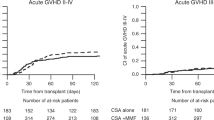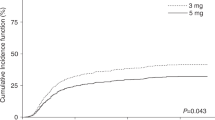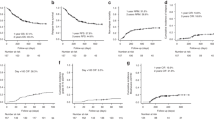Abstract
There is currently a major concern regarding the optimal immunosuppression therapy to be administered after hematopoietic stem cell transplantation (HSCT) to reduce both the toxicity of GvHD and the rate of relapse. We report the outcome of high-risk leukemia children transplanted with a new way of managing cyclosporine (CsA)-based GvHD prophylaxis. A total of 110 HSCT in 109 ALL or AML children who received CsA without mycophenolate or methotrexate in matched related as well as in matched or mismatched unrelated stem cell transplantation were included. CsA dosage regimens were individualized to obtain specific trough blood concentrations values. The incidences of grade I–II and III–IV acute GvHD were 69.1% and 1.8%, respectively, and 8.4% for chronic GvHD. GvHD was neither more frequent nor severe in unrelated than in related HSCT. GvHD occurred in 87% of patients with a mean CsA trough concentration ⩽120 ng/mL versus 43% with concentration >120 ng/mL (P<0.0001). Five-year disease-free survival (DFS) and overall survival were 78% and 83.6%, respectively. DFS was 76.9% for ALL and 80.4% for AML patients. There was no difference in DFS between matched siblings and matched unrelated or mismatched unrelated HSCT. DFS in patients with minimal residual disease (MRD) ⩾10−3 and in those with MRD <10−3 before SCT was comparable. Our results indicate that a GvHD prophylaxis regimen based on CsA without mycophenolate or methotrexate is safe and effective whatever the donor compatibility is. These results suggest that GvL effect may be enhanced by this strategy of GvHD prophylaxis.
This is a preview of subscription content, access via your institution
Access options
Subscribe to this journal
Receive 12 print issues and online access
$259.00 per year
only $21.58 per issue
Buy this article
- Purchase on Springer Link
- Instant access to full article PDF
Prices may be subject to local taxes which are calculated during checkout

Similar content being viewed by others
References
Weiden PL, Flournoy N, Thomas ED, Prentice R, Fefer A, Buckner CD et al. Antileukemic effect of graft-versus-host disease in human recipients of allogeneic marrow grafts. N Engl J Med 1979; 300: 1068–1073.
Horowitz MM, Gale RP, Sondel PM, Goldman JM, Kersey J, Kolb HJ et al. Graft-versus-leukemia reactions after bone marrow transplantation. Blood 1990; 75: 555–562.
Jiang YZ, Kanfer EJ, Macdonald D, Cullis JO, Goldman JM, Barrett AJ . Graft-versus-leukaemia following allogeneic bone marrow transplantation: emergence of cytotoxic T lymphocytes reacting to host leukaemia cells. Bone Marrow Transplant 1991; 8: 253–258.
Keever CA, Klein J, Leong N, Copelan EA, Avalos BR, Kapoor N et al. Effect of GVHD on the recovery of NK cell activity and LAK precursors following BMT. Bone Marrow Transplant 1993; 12: 289–295.
Kataoka I, Kami M, Takahashi S, Kodera Y, Miyawaki S, Hirabayashi N et al. Clinical impact of graft-versus-host disease against leukemias not in remission at the time of allogeneic hematopoietic stem cell transplantation from related donors. Bone Marrow Transplant 2004; 34: 711–719.
Peters C, Minkov M, Gadner H, Klingebiel T, Vossen J, Locatelli F et al. Statement of current majority practices in graft-versus-host disease prophylaxis and treatment in children. Bone Marrow Transplant 2000; 26: 405–411.
Lee KH, Choi SJ, Lee JH, Kim S, Seol M, Lee YS et al. Cyclosporine alone versus cyclosporine plus methotrexate for post-transplant immunosuppression after HLA-identical sibling bone marrow transplantation: a randomized prospective study. Bone Marrow Transplant 2004; 34: 627–636.
Martin P, Bleyzac N, Souillet G, Galambrun C, Bertrand Y, Maire PH et al. Relationship between CsA trough blood concentration and severity of acute graft-versus-host disease after paediatric stem cell transplantation from matched-sibling or unrelated donors. Bone Marrow Transplant 2003; 32: 777–784.
Ram R, Storer B, Mielcarek M, Sandmaier BM, Maloney DG, Martin PJ et al. Association between calcineurin inhibitor blood concentrations and outcomes after allogeneic hematopoietic cell transplantation. Biol Blood Marrow Transplant 2012; 18: 414–422.
Gérard C, Bleyzac N, Girard P, Freyer G, Bertrand Y, Tod M . Links between cyclosporin exposure in tissues and graft-versus-host disease in pediatric bone marrow transplantation: analysis by a PBPK model. Pharm Res 2011; 28: 531–539.
Martin P, Bleyzac N, Souillet G, Galambrun C, Bertrand Y, Maire PH et al. Clinical and pharmacological risk factors for acute graft-versus-host disease after paediatric bone marrow transplantation from matched-sibling or unrelated donors. Bone Marrow Transplant 2003; 32: 881–887.
Willemze AJ, Press RR, Lankester AC, Egeler RM, den Hartigh J, Vossen JM . CsA exposure is associated with acute GVHD and relapse in children after SCT. Bone Marrow Transplant 2010; 45: 1056–1061.
Bleyzac N . The use of pharmacokinetic models in paediatric onco-haematology: effects on clinical outcome through the examples of busulfan and cyclosporine. Fundam Clin Pharmacol 2008; 22: 605–608.
Domenech C, Suciu S, De Moerloose B, Mazingue F, Plat G, Ferster A et al. Dexamethasone (6 mg/m2/day) and prednisolone (60 mg/m2/day) were equally effective as induction therapy for childhood acute lymphoblastic leukemia in the EORTC CLG 58951 randomized trial. Haematologica 2014; 99: 1220–1227.
Biondi A, Schrappe M, De Lorenzo P, Castor A, Lucchini G, Gandemer V et al. Imatinib after induction for treatment of children and adolescents with Philadelphia-chromosome-positive acute lymphoblastic leukaemia (EsPhALL): a randomised, open-label, intergroup study. Lancet Oncol 2012; 13: 936–945.
Mann G, Attarbaschi A, Schrappe M, De Lorenzo P, Peters C, Hann I et al. Improved outcome with hematopoietic stem cell transplantation in a poor prognostic subgroup of infants with mixed-lineage-leukemia (MLL)-rearranged acute lymphoblastic leukemia: results from the Interfant-99 Study. Blood 2010; 116: 2644–2650.
Tallen G, Ratei R, Mann G, Kaspers G, Niggli F, Karachunsky A et al. Long-term outcome in children with relapsed acute lymphoblastic leukemia after time-point and site-of-relapse stratification and intensified short-course multidrug chemotherapy: results of trial ALL-REZ BFM 90. J Clin Oncol 2010; 28: 2339–2347.
Petit A, Ducassou S, Leblanc T, Pasquet M, Rousseau A, Ragu C et al. Relevance of a one-year maintenance therapy with interleukin-2 in the treatment of childhood acute myeloid leukemia: results from the French Multicenter, Phase III, Randomized Controlled SFCE Trial, ELAM02. Blood 2014; 124: 378.
Kaspers GJ, Zimmermann M, Reinhardt D, Gibson BE, Tamminga RY, Aleinikova O et al. Improved outcome in pediatric relapsed acute myeloid leukemia: results of a randomized trial on liposomal daunorubicin by the International BFM Study Group. J Clin Oncol 2013; 31: 599–607.
Dessars B, Cotton F, Thiry P, Gulbis B . Comparison of automated ACMIA and EMIT immunoassays for whole blood cyclosporin monitoring. Clin Lab 2003; 49: 135–140.
Glucksberg H, Storb R, Fefer A, Buckner CD, Neiman PE, Clift RA et al. Clinical manifestations of graft-versus-host disease in human recipients of marrow from HLA-matched sibling donors. Transplantation 1974; 18: 295–304.
van der Velden VH, van der Sluijs-Geling A, Gibson BE, te Marvelde JG, Hoogeveen PG, Hop WC et al. Clinical significance of flow cytometric minimal residual disease detection in pediatric acute myeloid leukemia patients treated according to the DCOG ANLL97/MRC AML12 protocol. Leukemia 2010; 24: 1599–1606.
Garand R, Beldjord K, Cavé H, Fossat C, Arnoux I, Asnafi V et al. Flow cytometry and IG/TCR quantitative PCR for minimal residual disease quantitation in acute lymphoblastic leukemia: a French multicenter prospective study on behalf of the FRALLE, EORTC and GRAALL. Leukemia 2013; 27: 370–376.
Rubnitz JE, Inaba H, Dahl G, Ribeiro RC, Bowman WP, Taub J et al. Minimal residual disease-directed therapy for childhood acute myeloid leukaemia: results of the AML02 multicentre trial. Lancet Oncol 2010; 11: 543–552.
Gandemer V, Pochon C, Oger E, Dalle JH, Michel G, Schmitt C et al. Clinical value of pre-transplant minimal residual disease in childhood lymphoblastic leukaemia: the results of the French minimal residual disease-guided protocol. Br J Haematol 2014; 165: 392–401.
Zhang P, Chen BJ, Chao NJ . Prevention of GVHD without losing GVL effect: windows of opportunity. Immunol Res 2011; 49: 49–55.
Balduzzi A, Di Maio L, Silvestri D, Songia S, Bonanomi S, Rovelli A et al. Minimal residual disease before and after transplantation for childhood acute lymphoblastic leukaemia: is there any room for intervention? Br J Haematol 2014; 164: 396–408.
Copelan EA, Hamilton BK, Avalos B, Ahn KW, Bolwell BJ, Zhu X et al. Better leukemia-free and overall survival in AML in first remission following cyclophosphamide in combination with busulfan compared with TBI. Blood 2013; 122: 3863–3870.
Dini G, Zecca M, Balduzzi A, Messina C, Masetti R, Fagioli F et al. No difference in outcome between children and adolescents transplanted for acute lymphoblasticleukemia in second remission. Blood 2011; 118: 6683–6690.
Fagioli F, Quarello P, Zecca M, Lanino E, Rognoni C, Balduzzi A et al. Hematopoietic stem cell transplantation for children with high-risk acute lymphoblastic leukemia in first complete remission: a report from the AIEOP registry. Haematologica 2013; 98: 1273–1281.
Locatelli F, Masetti R, Rondelli R, Zecca M, Fagioli F, Rovelli A et al. Outcome of children with high-risk acute myeloid leukemia given autologous or allogeneic hematopoietic cell transplantation in the AIEOP AML-2002/01 study. Bone Marrow Transplant 2015; 50: 181–188 Erratum in: Bone Marrow Transplant 2015; 50: 320.
Peters C, Schrappe M, von Stackelberg A, Schrauder A, Bader P, Ebell W et al. Stem-cell transplantation in children with acute lymphoblastic leukemia: a prospective international multicenter trial comparing sibling donors with matched unrelated donors—the ALL-SCT-BFM-2003 Trial. J Clin Oncol 2015; 33: 1265–1274.
Zheng C, Tang B, Tong J, Liu H, Geng L, Wang X et al. Unrelated cord blood transplantation for central nervous system relapse in high-risk childhood acute lymphoblastic leukemia. Ann Hematol 2013; 92: 1665–1673.
Koh KN, Park M, Kim BE, Bae KW, Im HJ, Seo JJ . Favorable outcomes after allogeneic hematopoietic stem cell transplantation in children with high-risk or advanced acute myeloid leukemia. J Pediatr Hematol Oncol 2011; 33: 281–288.
Nemecek ER, Ellis K, He W, Bunin NJ, Bajwa RS, Cheerva A et al. Outcome of myeloablative conditioning and unrelated donor hematopoietic cell transplantation for childhood acute lymphoblastic leukemia in third remission. Biol Blood Marrow Transplant 2011; 17: 1833–1840.
Thiel E, Zhang MJ, Davies SM, Logan B, Tiedemann K, Eapen M et al. Comparison of outcomes after HLA-matched sibling and unrelated donor transplantation for children with high-risk acute lymphoblastic leukemia. Biol Blood Marrow Transplant 2012; 18: 1204–1210.
Weiss M, Steinbach D, Zintl F, Beck J, Gruhn B . Superior outcome using cyclosporin A alone versus cyclosporin A plus methotrexate for post-transplant immunosuppression in children with acute leukemia undergoing sibling hematopoietic stem cell transplantation. J Cancer Res Clin Oncol 2015; 141: 1089–1094.
Conter V, Valsecchi MG, Parasole R, Putti MC, Locatelli F, Barisone E et al. Childhood high-risk acute lymphoblastic leukemia in first remission: results after chemotherapy or transplant from the AIEOP ALL 2000 study. Blood 2014; 123: 1470–1478.
Sutton R, Shaw PJ, Venn NC, Law T, Dissanayake A, Kilo T et al. Persistent MRD before and after allogeneic BMT predicts relapse in children with acute lymphoblastic leukaemia. Br J Haematol 2015; 168: 395–404.
Pession A, Masetti R, Rizzari C, Putti MC, Casale F, Fagioli F et al. Results of the AIEOP AML 2002/01 multicenter prospective trial for the treatment of children with acute myeloid leukemia. Blood 2013; 122: 170–178.
Wang H, Grzywacz B, Sukovich D, McCullar V, Cao Q, Lee AB et al. The unexpected effect of cyclosporin A on CD56+CD16− and CD56+CD16+ natural killer cell subpopulations. Blood 2007; 110: 1530–1539.
Eissens DN, Van Der Meer A, Van Cranenbroek B, Preijers FW, Joosten I . Rapamycin and MPA, but not CsA, impair human NK cell cytotoxicity due to differential effects onNK cell phenotype. Am J Transplant 2010; 10: 1981–1990.
Ohata K, Espinoza JL, Lu X, Kondo Y, Nakao S . Mycophenolic acid inhibits natural killer cell proliferation and cytotoxic function: a possible disadvantage of including mycophenolate mofetil in the graft-versus-host disease prophylaxis regimen. Biol Blood Marrow Transplant 2011; 17: 205–213.
Meehan AC, Mifsud NA, Nguyen TH, Levvey BJ, Snell GI, Kotsimbos TC et al. Impact of commonly used transplant immunosuppressive drugs on human NK cell function is dependent upon stimulation condition. PLoS One 2013; 8: e60144.
Brenner BG, Friedman G, Margolese RG . The relationship of clinical status and therapeutic modality to natural killer cell activity in human breast cancer. Cancer 1985; 56: 1543–1548.
Rosenthal GJ, Germolec DR, Lamm KR, Ackermann MF, Luster MI . Comparative effects on the immune system of methotrexate and trimetrexate. Int J Immunopharmacol 1987; 9: 793–801.
Matheson DS, Green B, Hoar DI . The influence of methotrexate and thymidine on the human natural killer cell function in vitro. J Immunol 1983; 131: 1619–1621.
Stein CM, Murray JJ, Wood AJ . Inhibition of stimulated interleukin-2 production in whole blood: a practical measure of cyclosporine effect. Clin Chem 1999; 45: 1477–1484.
van Rood JJ, Scaradavou A, Stevens CE . Indirect evidence that maternal microchimerism in cord blood mediates a graft-versus-leukemia effect in cord blood transplantation. Proc Natl Acad Sci U S A 2012; 109: 2509–2514.
Vitale C, Cottalasso F, Montaldo E, Moretta L, Mingari MC . Methylprednisolone induces preferential and rapid differentiation of CD34+ cord blood precursors toward NK cells. Int Immunol 2008; 20: 565–575.
Vitale C, Chiossone L, Cantoni C, Morreale G, Cottalasso F, Moretti S et al. The corticosteroid-induced inhibitory effect on NK cell function reflects down-regulation and/or dysfunction of triggering receptors involved in natural cytotoxicity. Eur J Immunol 2004; 34: 3028–3038.
Giebel S, Dziaczkowska J, Wojnar J, Wojnar J, Krawczyk-Kulis M, Markiewicz M et al. The impact of immunosuppressive therapy on an early quantitative NK cell reconstitution after allogeneic haematopoietic cell transplantation. Ann Transplant 2005; 10: 29–33.
Veys P, Wynn RF, Ahn KW, Samarasinghe S, He W, Bonney D et al. Impact of immune modulation with in vivo T-cell depletion and myleoablative total body irradiation conditioning on outcomes after unrelated donor transplantation for childhood acute lymphoblastic leukemia. Blood 2012; 119: 6155–6161.
Bitan M, He W, Zhang MJ, Abdel-Azim H, Ayas MF, Bielorai B et al. Transplantation for children with acute myeloid leukemia: a comparison of outcomes with reduced intensity and myeloablative regimens. Blood 2014; 123: 1615–1620.
Leung W, Pui CH, Coustan-Smith E, Yang J, Pei D, Gan K et al. Detectable minimal residual disease before hematopoietic cell transplantation is prognostic but does not preclude cure for children with very-high-risk leukemia. Blood 2012; 120: 468–472.
Bachanova V, Burke MJ, Yohe S, Cao Q, Sandhu K, Singleton TP et al. Unrelated cord blood transplantation in adult and pediatric acute lymphoblastic leukemia: effect of minimal residual disease on relapse and survival. Biol Blood Marrow Transplant 2012; 18: 963–968.
Walter RB, Buckley SA, Pagel JM, Wood BL, Storer BE, Sandmaier BM et al. Significance of minimal residual disease before myeloablative allogeneic hematopoietic cell transplantation for AML in first and second complete remission. Blood 2013; 122: 1813–1821.
Pulsipher MA, Langholz B, Wall DA, Schultz KR, Bunin N, Carroll W et al. Risk factors and timing of relapse after allogeneic transplantation in pediatric ALL: for whom and when should interventions be tested? Bone Marrow Transplant 2015; 50: 1173–1179.
Author information
Authors and Affiliations
Corresponding author
Ethics declarations
Competing interests
The authors declare no conflict of interest.
Rights and permissions
About this article
Cite this article
Bleyzac, N., Cuzzubbo, D., Rénard, C. et al. Improved outcome of children transplanted for high-risk leukemia by using a new strategy of cyclosporine-based GVHD prophylaxis. Bone Marrow Transplant 51, 698–704 (2016). https://doi.org/10.1038/bmt.2015.350
Received:
Revised:
Accepted:
Published:
Issue Date:
DOI: https://doi.org/10.1038/bmt.2015.350
This article is cited by
-
Impact of measurable residual disease by decentralized flow cytometry: a PETHEMA real-world study in 1076 patients with acute myeloid leukemia
Leukemia (2021)
-
A decision support tool to find the best cyclosporine dose when switching from intravenous to oral route in pediatric stem cell transplant patients
European Journal of Clinical Pharmacology (2020)
-
Bayesian Networks: A New Approach to Predict Therapeutic Range Achievement of Initial Cyclosporine Blood Concentration After Pediatric Hematopoietic Stem Cell Transplantation
Drugs in R&D (2018)



